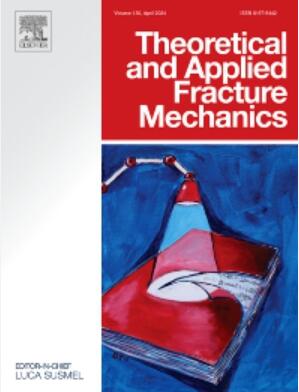Damage and energy evolution characteristics of pre-cracked sandstone under multi-stage amplitude-increasing cyclic loading
IF 5.6
2区 工程技术
Q1 ENGINEERING, MECHANICAL
引用次数: 0
Abstract
To systematically investigate the damage evolution and energy dissipation mechanisms associated with rock fracture induced by cyclic disturbance, a series of multi-stage amplitude-increasing cyclic loading tests are conducted on red sandstone specimens containing elliptical pre-existing flaws. The results indicate that, under low-cycle fatigue loading, the peak stress of red sandstone specimens shows a V-shaped variation with increasing defect inclination, with a minimum-to-maximum difference of 26.3 %. In contrast, the peak stress exhibits a W-shaped variation with increasing defect size, with a difference of 18.9 %. Under low-cycle fatigue loading, the elastic modulus exhibits significant hardening and can be modeled accurately with a quadratic function. Furthermore, the evolution of damage with respect to the fatigue life ratio (N/Nf, where N represents the current cycle count and Nf denotes the total number of cycles) can be categorized into three stages: an initial rapid increase stage (0 ≤ N/Nf < 0.2), a middle steady increase stage (0.2 ≤ N/Nf ≤ 0.8), and a late rapid increase stage (0.8 < N/Nf ≤ 1). Additionally, a one-dimensional constitutive equation describing the fatigue damage evolution of red sandstone is established. Energy calculation results demonstrate that both dissipated energy and elastic strain energy exhibit a trend of slow growth followed by sharp increases during the progression of fatigue life ratio. This change can be quantitatively characterized using an exponential function model. The ratio K, defined as the dissipated energy (density) to elastic strain energy (density), remains consistently below 0.7 throughout the evolution of low-cycle fatigue damage. It exhibits three distinct stages of variation as the fatigue life ratio increases. These research findings not only enhance the understanding of rock mass failure mechanisms induced by cyclic disturbances but also provide critical experimental evidence and theoretical support for the design, construction, and long-term stability assessment of deep rock mass engineering.
多级增幅循环加载下预裂砂岩损伤及能量演化特征
为系统研究循环扰动对岩石破坏的损伤演化和能量耗散机制,对含有椭圆预存缺陷的红砂岩试件进行了一系列多阶段增幅循环加载试验。结果表明:在低周疲劳载荷作用下,红砂岩试件的峰值应力随缺陷倾斜度的增大呈v型变化,最小与最大差值为26.3%;峰值应力随缺陷尺寸的增大呈w型变化,差异达18.9%。在低周疲劳载荷下,弹性模量表现出明显的硬化,可以用二次函数精确建模。损伤随疲劳寿命比(N/Nf,其中N表示当前循环次数,Nf表示总循环次数)的演变可分为三个阶段:初始快速增加阶段(0≤N/Nf <;0.2)、中期稳定增长阶段(0.2≤N/Nf≤0.8)和后期快速增长阶段(0.8 <;N/Nf≤1)。建立了描述红砂岩疲劳损伤演化的一维本构方程。能量计算结果表明,随着疲劳寿命比的增大,耗散能和弹性应变能均呈现先缓慢增长后急剧增加的趋势。这种变化可以用指数函数模型定量表征。在低周疲劳损伤过程中,耗散能(密度)与弹性应变能(密度)之比K始终保持在0.7以下。随着疲劳寿命比的增大,它呈现出三个不同的变化阶段。这些研究成果不仅加深了对循环扰动诱发岩体破坏机制的认识,而且为深部岩体工程的设计、施工和长期稳定性评价提供了重要的实验依据和理论支持。
本文章由计算机程序翻译,如有差异,请以英文原文为准。
求助全文
约1分钟内获得全文
求助全文
来源期刊

Theoretical and Applied Fracture Mechanics
工程技术-工程:机械
CiteScore
8.40
自引率
18.90%
发文量
435
审稿时长
37 days
期刊介绍:
Theoretical and Applied Fracture Mechanics'' aims & scopes have been re-designed to cover both the theoretical, applied, and numerical aspects associated with those cracking related phenomena taking place, at a micro-, meso-, and macroscopic level, in materials/components/structures of any kind.
The journal aims to cover the cracking/mechanical behaviour of materials/components/structures in those situations involving both time-independent and time-dependent system of external forces/moments (such as, for instance, quasi-static, impulsive, impact, blasting, creep, contact, and fatigue loading). Since, under the above circumstances, the mechanical behaviour of cracked materials/components/structures is also affected by the environmental conditions, the journal would consider also those theoretical/experimental research works investigating the effect of external variables such as, for instance, the effect of corrosive environments as well as of high/low-temperature.
 求助内容:
求助内容: 应助结果提醒方式:
应助结果提醒方式:


